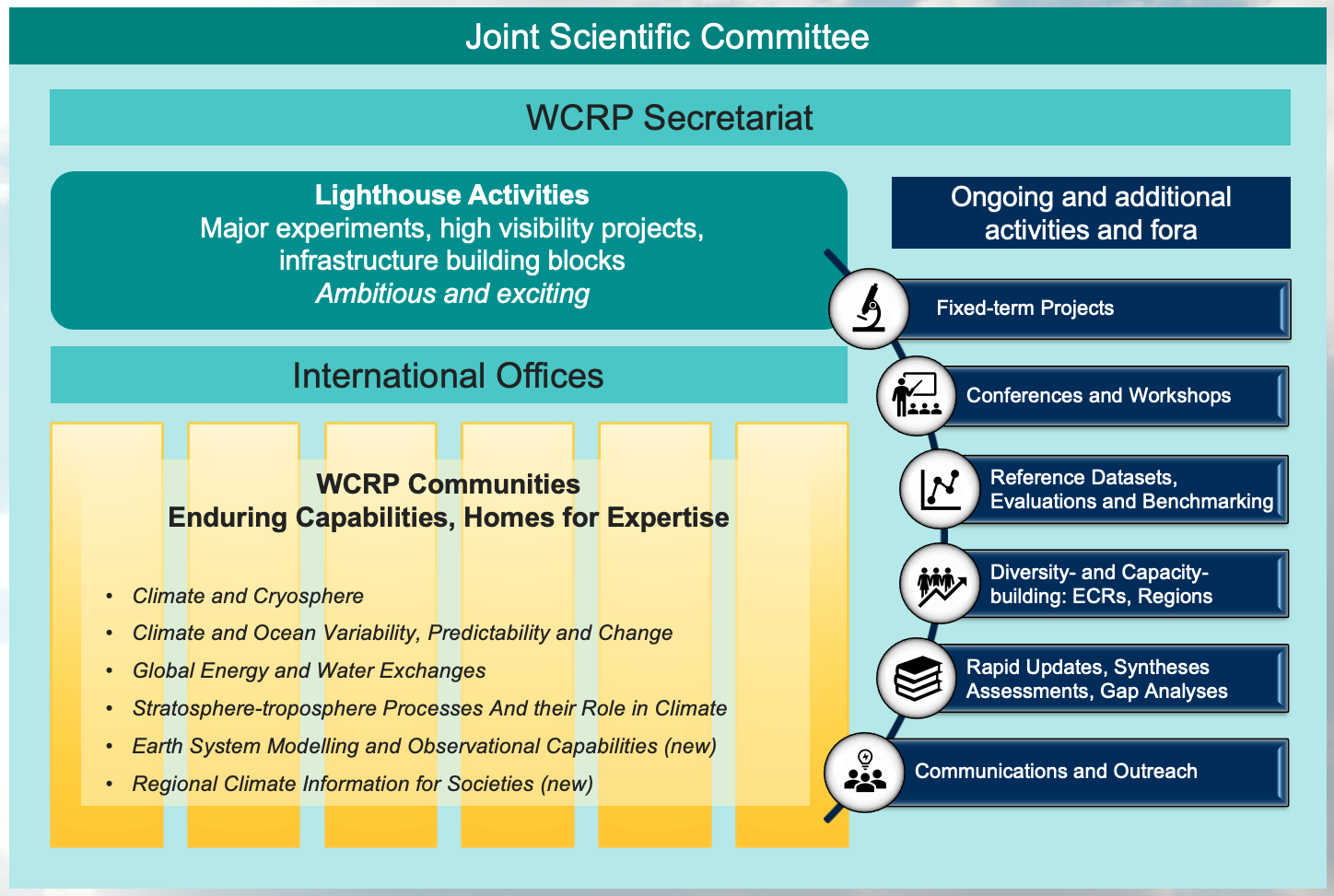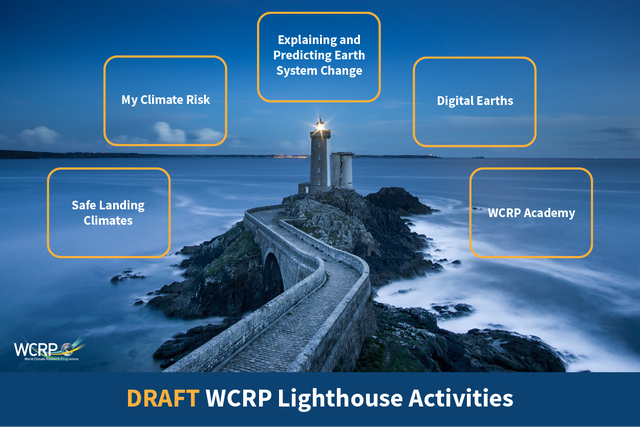From 30 November to 3 December 2020, the WCRP Community leadership will present and discuss provisional plans to start a soft launch of a reformed WCRP in early 2021. While the final form and elements of the new WCRP are still being discussed and decided, we outline some of the things that you can expect to happen.
1. The Core Projects will remain, but may no longer be called 'projects'
The four WCRP Core Projects, Climate and Cryosphere (CliC), Climate and Ocean Variability, Predictability and Change (CLIVAR), Global Energy and Water Exchanges (GEWEX), and Stratosphere-troposphere Processes And their Role in Climate (SPARC), will remain key elements within WCRP. Each Core Project will conduct an internal review, including looking at how to optimize their internal structure and how they can work much closer with other parts of the WCRP family. The name 'Core Project' has long been thought of as a misnomer. Unlike the WCRP Core Projects, which have been active for decades, a 'project' is usually a temporary endeavor. In recent months the word 'home' has been used, as these are the homes of WCRP core communities and capabilities, but the final terminology is not yet settled.
VOTE: A new name for WCRP Core Projects?
2. WCRP modelling and data activities will be brought together in one 'home'
At present, WCRP has a Modelling Advisory Council, a Data Advisory Council, and a number of working groups dedicated to advancing modelling, including the Working Group on Coupled Modelling (WGCM), the Working Group on Subseasonal to Interdecadal Prediction (WGSIP), and the co-sponsored* Working Group on Numerical Experimentation (WGNE) and Subseasonal-to-Seasonal (S2S) Prediction Project. It is likely that the activities of all of these groups will be brought together into a new 'home' on Earth System Modelling and Observational Capabilities (name is provisional). The aim is to bring modelling, observational, and data communities closer together. This 'home' will also be cross-cutting, as there will need to be communication with those involved in modelling, observation, and data activities across WCRP. How this will look in practice is still under discussion.
3. A new 'home' for Regional Climate Information for Societies is likely
In the WCRP Strategic Plan 2019-2028, one of the four Scientific Objectives is 'Bridging Climate Science and Society'. In order to achieve this objective, WCRP needs to build stronger capabilities in this area and have a clear 'entry point' into WCRP from programmes and agencies outside of WCRP. It is likely that a new 'home', provisionally entitled Regional Climate Information for Societies, will be set up to support the objective. The core expertise of the home is likely to be built around the Coordinated Regional Climate Downscaling Experiment (CORDEX), with additional elements, including ideas from some members of the currently inactive Working Group on Regional Climate. How this will be structured is still under discussion, but it will also need to be cross-cutting in order to deliver useful and useable information to society.

Above: The draft WCRP structure. 'Homes' are in yellow and include the four current WCRP Core Projects and two additional homes, as outlined above. Lighthouse Activities are highly visible activities, integrated across the Programme (see description below). Ongoing activities and fora, in blue, can take place throughout the Programme and allow WCRP to be flexible and to respond rapidly when necessary.
4. New Lighthouse Activities will be designed to integrate across the WCRP community
WCRP is in the process of launching five new ambitious 'Lighthouse Activities,' which are high-visibility projects that aim to integrate capabilities across WCRP and with partners to address some of the most pressing challenges of the coming decade(s). Outlines of these activities have been produced and the first report on their science plans is on the agenda for the upcoming Extraordinary JSC Session. It is important to note that the Lighthouse Activities are just forming now, so the co-design process across WCRP and with partners is just beginning.

Above: The provisional names of the proposed WCRP Lighthouse Activities.
5. The WCRP Grand Challenges will sunset by the end of 2022
The seven WCRP Grand Challenges have resulted in excellent science that has significantly contributed to the questions that they are addressing. While they are not all following the same timelines, they are all set to sunset by the end of 2022. While some of the work of the Challenges is complete, research that is ongoing and important will be continued by the WCRP 'homes' and the new Lighthouse Activities.
6. The number of WCRP International Offices will most likely grow
In the provisional plan, each WCRP 'home' will have an international office to support its activities. For the existing Core Projects, the current International Project Offices will be retained. For the two new homes, the situation is more complicated. There is not yet a modelling and data international office to support the Earth System Modelling and Observational Capabilities home and, separately, a new project office for the WCRP Coupled Model Intercomparison Project will soon be announced. The Regional Climate Information for Societies home is aligned with both the International Project Office for CORDEX and the Coordination Office for Regional Activities (CORA). How that interplay will be organized will depend on the structure of the home and the support needed. In addition, the Lighthouse Activities will most likely be supported across the international offices, although how this will work will depend on what makes the most sense in terms of the support needed.
7. The new WCRP will be more flexible and reactive
An important feature of the new WCRP will be the ability to be flexible and reactive to fast-changing events. This is built into the Programme's implementation planning in two ways. First of all, the WCRP Implementation Plan will be a living document, updated periodically to change how the Programme operates. In addition, there will be mechanisms to develop fixed-term projects, rapid updates, syntheses assessments, and gap analyses where needed.
8. There will be a focus on increasing diversity
The geographical and gender diversity across WCRP requires improvement. There is a strong commitment to do this at the leadership level and to ensure that the Programme reaches out beyond current networks. WCRP is also committed to ensuring that the next generation of climate scientists contribute to building a WCRP that is fit for the future. From 2021 onwards, WCRP will embark on a series of WCRP Climate Research Forums that aim to exchange information and discuss climate research in the different regions and sub-regions of the world. The Forums will explain new activities that are being developed under the WCRP strategy, and how you can be involved.
Register your interest in being part of the WCRP Climate Research Forums
9. WCRP Open Science Conference
WCRP plans to hold an Open Science Conference to celebrate the outcomes of the WCRP Grand Challenges and to roll out the new WCRP. The Conference will come about a decade after the first pan-WCRP conference hold in Denver in 2011. It will again span the breadth of WCRP science and will involve co-sponsors and partners in its co-design and delivery. The location of the conference is yet to be determined, but it is envisioned that it will take place as a face-to-face meeting with virtual components towards the end of 2022 or at the start of 2023.
Further information:
- Article: WCRP forges a new climate science future - July 2020
- Slideshow: World Climate Research Programme: Our Climate Future (PPT) - July 2020
- Report of the 41st session of the Joint Scientific Committee - June 2020
* S2S is co-sponsored by WCRP and the World Weather Research Programme (WWRP). WGNE is co-sponsored by WCRP, WWRP, and the Global Atmosphere Watch (GAW).

